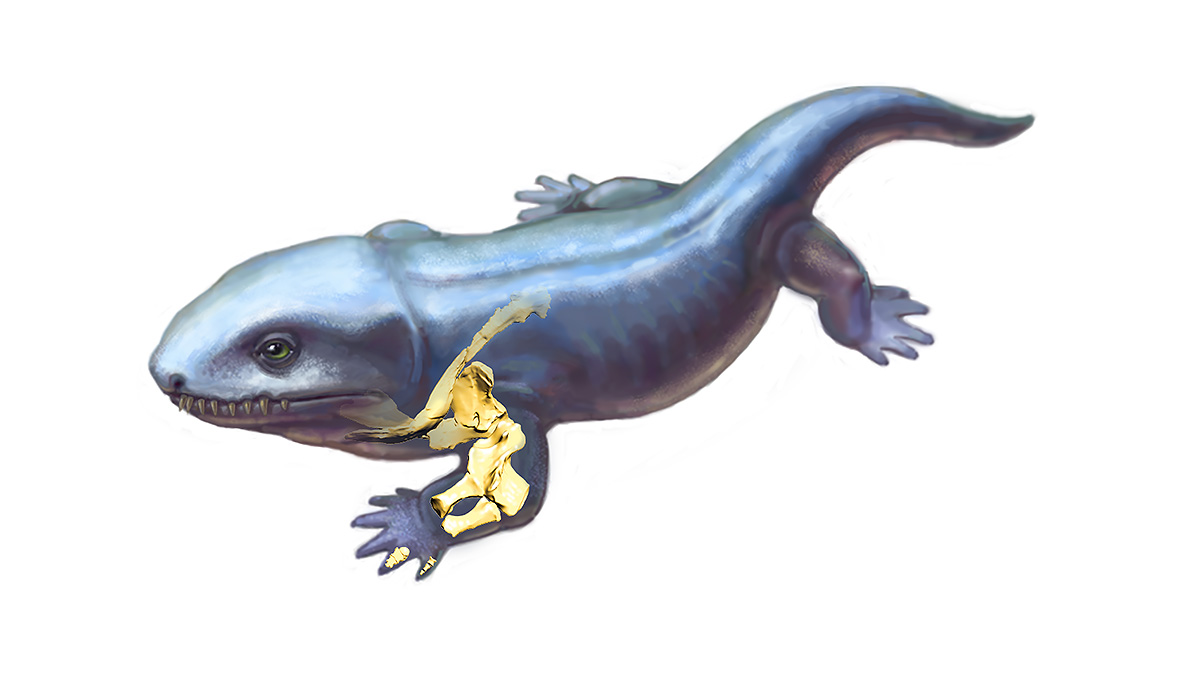British researchers have reconstructed for the first time how a famous extinct animal – the early tetrapod called Ichthyostega – moved on land.

Reconstruction of the whole body of Ichthyostega (Julia Molnar)
The study, published in Nature, examines limb mobility in the 360 million year old fossil tetrapod by reconstructing the first ever 3D computer model of its skeleton.
“It took almost three years of hard work on difficult fossil material, but we are finally able to see how the skeleton of Ichthyostega fits together and might have moved in three-dimensions. This is very exciting, as it allows us to examine how ancient vertebrates made the monumental transition from swimming to walking,” said lead author Dr Stephanie Pierce of the Royal Veterinary College.
To test how the limbs of Ichthyostega moved, the team scanned dozens of fossil specimens and digitally separated the bones from surrounding rock. Each bone was then carefully put back together like a jigsaw puzzle in animation software and painstakingly manipulated to estimate each joint’s maximal range of motion.

“Our reconstruction demonstrates that the old idea, often seen in popular books and museum displays, of Ichthyostega looking and walking like a large salamander, with four sturdy legs, is incorrect,” explained study co-author Prof Jennifer Clack of the University of Cambridge.
By comparing their data to five living animals (salamander, crocodile, platypus, seal, and otter), the scientists found that the shoulder and hip joints in Ichthyostega were unusually restricted in their motions, meaning the animal could not have used a conventional ‘walking’ step. In particular, the study uncovered that the limbs in Ichthyostega were incapable of rotating along their long-axis – a limb motion critical to locomotion in living land animals.

Study co-author Prof John R Hutchinson from the Royal Veterinary College said: “remarkably, earlier fishes (called tetrapodomorphs) had the ability to rotate their fins, so it seems that just as vertebrates were experimenting with terrestrial movement, the limbs became confined to mainly back-and-forth and up-and-down motions. It wasn’t until tetrapods became more competent on land that they recovered the ability to rotate their limbs around their long axis.”
According to the study, a limited capacity to rotate the limbs implies that some of the earliest land animals could not walk well on all four legs. In particular, manipulation of the 3D model demonstrates that land locomotion in Ichthyostega-like animals would probably have involved synchronized motions of the front legs, with the hind legs barely being able to reach the ground and probably playing a more minor supportive role along with the tail.

“These early tetrapods probably moved in a similar way to living mudskipper fishes in which the front fins/legs are used like crutches to haul the body up and forward,” Dr Pierce said. “As early tetrapods were still mostly aquatic, this type of movement may have helped to stabilize the body during their first tentative forays onto land.”
The next step for the scientists is to combine their models of limb motion with similar models of the rest of the skeleton as well as muscles, to make much more sophisticated biomechanical analyses of just how these animals did or did not move, and how well they were able to do it.
Source: sci.news








